Theoretical and methodological issues. Рубрика в журнале - Economic and Social Changes: Facts, Trends, Forecast
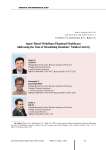
Статья научная
The article addresses the task concerning the development of techniques for formalizing the behavior of agents-users of medical services in agent-based models designed to support decision-making on the spatial layout of health infrastructure facilities in the region. We analyze approaches to determining the behavior patterns of consumers of medical services and, on this basis, develop the structure of agents' behavior model. We consider the implementation of the proposed model with the help of fuzzy neural networks. While forming the network, we use the results of a sociological survey conducted by Vologda Research Center in the territory of the Vologda Oblast in 2020. Practical implementation of the network is carried out in the Microsoft Access environment. Using this tool, we conduct a number of experiments to determine residents' medical activity based on the initial data of the sociological survey. We use general scientific methods of formalization, abstraction, generalization, methods of system analysis, mathematical statistics, and fuzzy logic. The results of our work consist in designing the structure of behavior model for agents-consumers of medical services and methods for its implementation. Scientific novelty of our findings consists in the proposed structure of behavior model of agents-consumers of medical services and its practical implementation with the use of fuzzy neural networks in relation to the manifestation of medical activity. Practical significance of the results lies in the fact that the instrumental approaches proposed and partially tested in it will allow us to develop agent-based models of regional healthcare adequate to objective environmental conditions, taking into account citizens' attitudes and behavior motives in interaction with medical services. In the future, this will help us to put forward and adjust measures to improve the efficiency of spatial layout and functioning of networks. Further work will be related to the improvement of the proposed methods in the following areas: determining ways to train the developed fuzzy neural network and finding ways to implement the remaining elements of the developed model for agent behavior.
Бесплатно
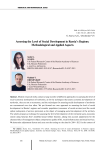
Assessing the level of social development in Russia’s regions: methodological and applied aspects
Статья научная
Modern research works contain a large number of different approaches to assessing the level of socio-economic development of territories; as for the techniques that assess economic development of territories, they are not so numerous; and the techniques for assessing social development of territories are encountered even less often. We put forward our own approach to assessing the level of social development in Russia’s regions and consider population (consumer of social services) and the social sphere (subsystem of services provision) as the object of managing social development of the territory. The article proposes a technique for assessing the level of development of the territorial socio-economic system using Amartya Sen’s modified social welfare function, taking into account adjustments for the characteristics of management object components: quality of life, social infrastructure and social services. We determine adjustment factors and carry out the testing on the data for 2014-2021 in the context of Russia’s constituent entities; we form a rating of regions according to the level and specifics of social development and identify four groups of regions: “social development leaders”, “socially developing”, “socially slowing down” and “socially undeveloped” regions.
Бесплатно
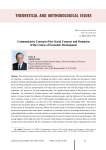
Communicative concept of the social contract and formation of the course of economic development
Статья научная
The article presents the communicative concept of the social contract. This concept focuses not on reaching a compromise, but on bringing the parties closer together during the discussion of their positions. Mutual understanding regarding the desired future of the socio-economic system is a necessary basis for determining the course of economic development with a communicative understanding of the social contract. Such an interpretation of it takes into account that not only the image of the future is important, the process of its joint comprehension, the organizational aspect of this process is no less important. As evidenced by foreign practice, with standard procedures of electoral democracy, state policy is formed under the influence of business-oriented groups, and the influence of the preferences of an ordinary citizen is close to zero. Information technologies have not only dramatically expanded communication capabilities, but also led to the identification of the information elite. The article analyzes the discussion about the influence of this elite on social development, including the discussion of the theory of information autocracy. When mass media leads to increased polarization of society, it increases investment risks and causes a slowdown in economic growth. As foreign studies show, a new technological elite occupies a special position on topical issues of modern socio-economic development. The elite is interested not only in new technological and economic results, but also in social progress. The strong support of the high-tech elite for income redistribution and progressive taxation allows us to take a fresh look at the prospects for the convergence of the positions of social clusters regarding the course of economic development. The communicative concept of the social contract is a suitable basis for the synthesis of ideas of social clusterism and collaborative democracy.
Бесплатно
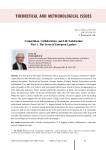
Competition, collaboration, and life satisfaction. Part 1. The seven of European leaders
Статья научная
The first part of this paper demonstrates that a group of seven European countries is significantly ahead of other Western states, including the United States, in the development of economic and political institutions. The Seven are Denmark, Norway, Sweden, Finland, Iceland, Switzerland, and the Netherlands. They rank first in the life satisfaction index (happiness index) and are leaders in the integral index of quality of life, civic culture, and institutional effectiveness which is formed by aggregating ten most important indicators. These include healthy life expectancy at birth, the corruption perception index, the democracy index, the human development index, the Gini index and a number of others. When this index is used to cluster the set of developed countries, the Seven appears to be the leading cluster. This result suggests that the achievement of high values of the proposed index contributes to the country’s advancement to the leading positions in life satisfaction. An analysis of the dynamics of institutional indicators showed that the U.S. lagging behind the Seven has been increasing over time. In recent years, the U.S. has been among the flawed democracies, the levels of generalized trust of U.S. citizens as well as trust in political institutions and in the government are decreasing, the U.S. advantages in terms of global competitiveness and per capita GDP are diminishing. The second part of the paper will consider what qualitative features of socio-economic and political mechanisms provide leadership, and how our findings can be used to develop catch-up strategies.
Бесплатно
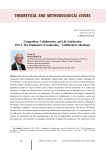
Статья научная
The first part of the paper showed that the group of seven European countries leading in the life satisfaction index (happiness index) significantly outperformed other Western nations, including the United States, in the development of economic and political institutions. The Seven includes Denmark, Norway, Sweden, Finland, Iceland, Switzerland, and the Netherlands. The second part examines what qualitative features of socio-economic and political mechanisms provide leadership. It is noted that attempts to explain this phenomenon by the low size of population and its homogeneity, as well as by the small area of these countries, are inadequate. The notion of collaborative advantages is introduced, understood as relatively more developed mechanisms of collaboration in the economic, social and political spheres. Based on three different classifications of types of capitalism and on an analysis of the history of countries of the Seven we show that they have reached the leading positions due to collaborative advantages. These countries are coordinated market economies, their economic systems are characterized as stakeholder capitalism, and their political systems are consensus democracies. The Seven of European Leaders carry out reforms aimed at improving collaboration mechanisms and, as a consequence, are less affected by the crisis of competitive institutions observed in Western societies. The presented results support the hypothesis that the strengthening of the role of collaboration mechanisms while reducing the importance of competitive mechanisms contributes to higher life satisfaction. The experience of the Seven is used by other developed European countries as well. The question of how our findings can be used in choosing a catching-up strategy is discussed.
Бесплатно
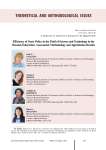
Статья научная
The article presents a methodology for evaluating the efficiency of measures and tools of state policy in the field of science and technology. The approach was developed and tested in order to improve the mechanism for monitoring the achievement of strategic goals of Russia’s scientific and technological development discussed at the meeting of the Presidential Council for Science and Education on February 8, 2023. The implementation of this direction is of great importance for ensuring technological sovereignty of the country. In the course of the research we used general scientific methods: analysis, synthesis and generalization, observation, comparison, measurement, grouping. Statistical methods such as correspondence analysis and cluster analysis were also used to implement the main task. The assessment was carried out in three directions: effectiveness assessment, assessment of the growth rate of targets, and assessment of the relevance of measures and tools of state policy in the field of science and technology by the scientific community. Based on these criteria, a set of data and a conclusion on the efficiency of public policy tools and measures were formed. The results obtained indicate the average efficiency of the tools and measures of state policy in terms of their effectiveness and relevance. The growth rates of most indicators are characterized by negative dynamics. This is primarily due to the fact that during the second stage of the implementation of the scientific and technological development strategy, restrictions caused by coronavirus infection were introduced, and we should also point out an increase in sanctions pressure.
Бесплатно
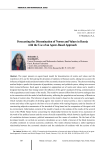
Forecasting the dissemination of norms and values in Russia with the use of an agent-based approach
Статья научная
The paper presents an agent-based model for dissemination of norms and values and the experience of its use for forecasting the dynamics of opinions in Russian society, taking into account the influence of digital media and deterioration of the economic situation in the country. The chosen modeling method helps to predict the dynamics of population, economy and political system, taking into account their mutual influence. Each agent is assigned an appropriate set of norms and values and a model is designed showing how they change under the influence of the agent’s standard of living, communication with acquaintances and impact of the media. The model we present differs from its known analogues due to its connection with the model of artificial society, reflecting the population and economy of Russia on the basis of current data. The behavior of agents in the model is based on the concept of a social agent, which includes the principles of dividing agents into clusters of social activity, a way to represent the norms and values of the agent in the form of a set of options with varying frequency and the function of constructing subjective assessments of the standard of living based on the comparison of the agent with its environment. Information content of the model is based on the analysis of the results of the seventh wave of the World Values Survey concerning the relationship between the income level, assessment of the work of the political system and the norms of social responsibility, which showed a significant degree of correlation between incomes, political assessments and the norms of residents. On the basis of the developed model, we carried out scenario calculations so as to build a forecast of the likely dynamics of public sentiment in various economic conditions. The results obtained indicate a rather significant relationship between the economic situation and the satisfaction of residents with the actions of the government. In the developed model, the change in a person’s beliefs is limited to their inner world; therefore, implementing new aspirations in attempts to change one’s own life or society is an important direction for future research.
Бесплатно
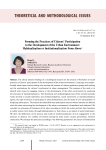
Статья научная
The article presents findings of a sociological research on the process of formation of social practices of citizens’ participation in the development of the urban environment. Creating a new, peoplefriendly urban space involves taking into account the interests of various population groups and working out the mechanisms for citizens’ involvement in urban management. The purpose of the work is to identify main ways for engaging citizens in the development of the urban environment by analyzing the processes of institutionalization. The theoretical and methodological basis of the research includes works devoted to social institutions and institutionalization, social movements as institutionalization agents, the right of citizens to participate in urban development, and the issues of civic participation in designing urban spaces. The analysis has identified main participants (actors) whose interests are affected when the issue concerning the development of the urban environment is formulated and addressed. We consider two processes of formation of the rules according to which the actors perform their functions in public arenas: from below through habitualization or from above as an import of social institutions. We show the differences in the process and results of institutionalization of civic engagement in the presence or absence of a conflict of interests among the main actors: society, government, business community. We compare the processes according to the following parameters: the nature of institutional changes, relations and actions, type of institutional changes, structure of political opportunities, and civic engagement levels. We draw conclusions about how the orientation of the processes affects the nature of civic participation. In particular, the loss of the “partnership” and “delegation of authority” stages in the process of institutionalization from above indicates a formal and imitative nature of the practices of civic participation in urban development. The novelty of the work consists in comparing the oppositely directed processes of institutionalization of civic participation (from below and from above) on the example of a specific sphere such as urban development.
Бесплатно
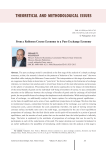
From a Robinson Crusoe economy to a pure exchange economy
Статья научная
The pure exchange model is considered as the first stage of the analysis of a simple exchange economy; at that, the research is based on the patterns of behavior of the “economic man” that were identified while studying the Robinson Crusoe model. The interpretation at this stage of production as an exogenous factor helps to determine in “pure form” the forces leading to the formation of exchange relations, to introduce into analysis and to reveal basic features of the main phenomena and processes in the sphere of circulation. Proceeding from well-known approaches to the impact of redistribution of the initial bundle of goods on the individual well-being of members of society, we pay considerable attention to the difference between the exchange of bundles of goods and the exchange of individual goods, the two possible forms of exchange that implement such redistribution. While studying the market form of exchange, we additionally analyze the known options for achieving general equilibrium - on the basis of equilibrium and a series of non-equilibrium proportions of exchange. We show that due to institutional reasons, competition between the participants of the exchange, as a tool for reducing transaction costs, cannot eliminate the costs completely; therefore, the path of moving toward the contract surface inevitably turns out to be multi-stage, accompanied by the use of non-equilibrium proportions of exchange. But the final (limit) point on this path will necessarily be a point of general equilibrium, and the number of such points that can be reached from the initial position is infinitely large. The latter is explained by the multitude of proportions of exchange that can be used by its participants at each of the nodal points of the path. The paper develops our viewpoint formulated in an earlier publication: the possibility of introducing credit relations into the analysis at this stage is associated with the existence of consumer goods of long-term use. At the same time, only the goods of long-term use can serve as the object of the credit and it is impossible to single out an "interest rate component" in the supplies that ensure the repayment of the credit.
Бесплатно
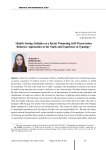
Статья научная
Under the conditions of conceptual transition of public health policy from considering citizens as passive consumers of medical services to their awareness of their own active position in health preservation, it becomes fundamentally important to understand the types of health care attitudes of the population. The aim of the study was to make a typology of the population according to the nature of health-saving attitudes and to study its influence on the dissemination of healthy lifestyle practices. We have analyzed and summarized approaches to the interpretation of health-saving motivation and classification of health care motives. We reviewed the experience of applying cluster analysis in studies of health behavior. We found that most of them use self-preservation practices as indicators for typology, while the equally important value-motivational component is most often left out of sight. Our study is designed to fill this gap. The results of the sociological monitoring of the physical health of the Vologda Oblast population in 2020 served as the information base. The motives of health care were considered in inseparable interrelation with the degree of health care and responsibility for it. We used the cluster analysis method (hierarchical and k-means method) to make a typology of the population. In the course of clustering we identified three groups of population according to the nature of health saving attitudes: 1) responsible, but unmotivated, caring little or no concern for health, 2) sharing responsibility, motivated and caring for health, 3) responsible, motivated and caring for health. We defined a socio-demographic portrait of representatives of each cluster. Representatives of the third cluster lead the healthiest way of life, while more than half of the respondents of the first cluster do not take any measures in relation to health. The results of the study have an explicit practical value in terms of managing self-preservation behavior.
Бесплатно
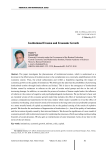
Institutional erosion and economic growth
Статья научная
The paper investigates the phenomenon of institutional erosion, which is understood as a decrease in the effectiveness of institutions due to the complication (or, conversely, simplification) of the economic system. Thus, the article substantiates and verifies a hypothesis regarding the impact of economic growth on the quality of institutions. We dwell upon the idea that the possibilities of preventing institutional erosion through timely reforms are limited. This is due to the emergence of institutional friction caused by resistance to reforms on the part of certain social groups and due to the rule of increasing damage. In addition, we consider the process of erosion of human capital under the influence of reforms in the context of cognitive and psychophysiological mechanisms. We put forward a basic and an extended version of the economic growth model that includes the effect of institutional erosion. We conduct computational experiments for the basic model, which made it possible to reveal the effect of economic overheating: a less intensive mode of investment in the long term turns out preferable compared to a more stressful mode of capital accumulation due to the gradual zeroing of the results of explosive growth. We describe the mechanism of degeneration of institutions (i.e., loss of the quality of institutions and the inversion of goals) caused by their internal dialectic. We discuss the significance of a new model of economic growth with institutional erosion for explaining the processes of both ascending and descending branches of social dynamics. We also give an interpretation of some important events of our time in the terms of the new theory.
Бесплатно
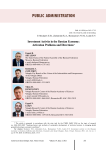
Investment activity in the Russian economy: activation problems and directions
Статья научная
The big challenges facing Russia require ensuring high-quality economic growth which makes it necessary to search for investment resources. However, financial crises, foreign policy pressure, coupled with the export-raw materials model of the Russian economy, do not allow achieving necessary growth investment rates in fixed assets. The purpose of the research is to find and scientifically substantiate ways to enhance investment activity in the Russian Federation. For this purpose, the authors have evaluated parameters of investment activity, have analyzed the sources of financial resources for investment, and have developed specific recommendations to increase investment activity in the Russian economy. The results of the study revealed a number of problems: strengthening of sectoral and territorial disparities, growing dependence on imports of investment goods, deterioration of technological development parameters, reduction of the share of Research and Development and Research and Technological Development in GDP, and reduction of debt financing opportunities. As ways to boost investment activity, the authors propose monetary policy adjustments, expansion of fiscal and tax incentives to support investment and RTD, and development of value chains aimed at smoothing resource allocation imbalances including investment ones. The scientific novelty of the research is in development applied directions for increasing investment activity in the modern Russian economy. The methodological basis is the theory of social reproduction and national accounting. The information base of the research consists of statistical data and materials of the Federal State Statistics Service, the Unified Interdepartmental Information and Statistical Service, input-output tables, the Bank of Russia, the Higher School of Economics, normative legal acts and program documents of the Russian Federation and its subjects, publications of Russian and foreign authors in various periodicals, monographs. Further scientific research will be related to the study of institutional factors of investment activity activation and forecasting the results of implementing the proposed recommendations.
Бесплатно
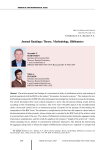
Journal rankings: theory, methodology, bibliometry
Статья научная
The article presents the findings of a scientometric study of publication activity and ranking of journals registered with the RSCI on the subject “Economics. Economic sciences”. The analysis of a new methodology proposed by the RSCI for determining journal rankings has revealed its serious shortcomings. The article formulates three main critical postulates to prove that the journal ranking results derived according to this methodology are incorrect. One of its most vulnerable aspects is the unsubstantiated choice of journals carried out by an anonymous group of experts for the purpose of determining the composition of the RSCI core. The situation is complicated by the fact that this subjective choice leads to the discrimination of other journals, whose citation rate is recorded in the RSCI only if the article is cited in a journal that is part of the core. The choice of bibliometric indicators determining the aggregate rating of journals is unsatisfactory, and first of all this applies to the indicator “length of the article text”, which, strictly speaking, has no relation to scientometric indicators whatsoever. The formula for determining the aggregate rating itself, in which the weights of bibliometric indicators are “adjusted” to comply with a certain expert rating from five years ago, cannot be called justified. The constructive criticism provided in the article is accompanied by a description of an alternative approach with the elimination of the identified shortcomings of the new RSCI methodology. We are talking about a fundamentally different way of allocating the journals core: it does not use subjective assessments of any expert groups; instead, it uses certain formal criteria related to the production of knowledge and its dissemination in the form of publication activity of academic institutes of the Russian Academy of Sciences and leading universities that are founders of economic journals. The article presents a new approach to the methodology for determining a journal rating based on the application of MW analysis (Multiway data analysis), which is a generalization of factor analysis applied to a multidimensional matrix. As a result, we put forward another set of journals included in the core; this ranking is called Yadro.RU; we also propose a more reasonable version for the ranking of journals registered with the RSCI on the subject “Economics. Economic sciences”.
Бесплатно
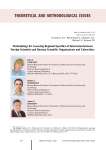
Статья научная
The article examines the features of interactions between Russian scientific organizations and universities and foreign scientists. Despite the effort to collect and compile data on different types of international interactions between scientists, Russian academic literature does not pay sufficient attention to the activities of foreign scientists working in Russia. Therefore, the purpose of the study is to close the gaps in scientific knowledge connected to the research on academic mobility including identification of types and features of interactions between Russian scientific organizations and foreign scientists, to discover the connection between academic mobility and productivity of scientists, and to improve methods of arrangement for the data related to the status and performance of the academia. To accomplish this goal, we propose a methodology for monitoring the interaction of Russian organizations with foreign scientists. We carry out the monitoring taking into account the priorities formulated in the Strategy of Scientific and Technological Development of the Russian Federation (hereinafter - STD Strategy of Russia). The monitoring provided the data about the quantity of foreign scientists, who visited Russian scientific organizations and higher education institutions in 2018 and 2019, the statistics on the distribution of foreign scientists working in Russia by age groups, by scientific fields, by types of interaction, and by Russian regions. The following issues require thorough consideration: the choice of parameters for assessing the work of educational and scientific organizations and the need to take into account priorities of STD Strategy of Russia for monitoring and evaluating the interaction between Russian organizations and foreign scientists, the presence or absence of stable links between the mobility of scientists and their scientific productivity, the absence and fragmentation of data on foreign scientists working in Russia, and flaws in the methods for collecting and monitoring such data. The methodology has been tested using data from previous surveys. Following the test, we propose specific steps for improving data collection on broad participation of Russia in global science processes. The obtained results can be used by private and state organizations, including the management of higher education organizations, heads of scientific organizations (scientific departments), which will serve as the basis for accurate positioning of Russia on the world map of scientific and technological cooperation.
Бесплатно

Modeling socio-demographic asymmetry of territorial development
Статья научная
The article explores the issues of modeling socio-demographic asymmetry using spatial econometrics. Its relevance is associated with the growing disproportions of demographic dynamics in the regional space that undoubtedly requires scientific understanding and development of appropriate management decisions. The purpose of this study is to substantiate the methodological provisions for modeling the socio-demographic asymmetry of territorial development using a case-study of a specific region. Based on an analysis of domestic and foreign publications on the study of the territorial development asymmetry, including socio-demographic one, the author proposes a typology of methodological approaches and methods of its modeling and evaluation and substantiates the need to use spatial econometrics methods, the advantage of which is not only an opportunity to assess the presence of the asymmetry phenomenon, but also to determine the links between studied territorial entities and evaluate their mutual influence in the conditions of uneven development of regional space. The calculation of Moran’s global and local indices using a case study of the Sverdlovsk Oblast’s settlement system allowed us to obtain the following results: (1) the presence of socio-demographic asymmetry in the form of spatial autocorrelation of the population indicators of the region’s municipalities was confirmed; (2)a typology of municipalities is proposed according to their contribution to the formation of socio-demographic asymmetry, which allowed us to determine the points of agglomeration attraction, as well as to show the presence of direct and inverse spatial relationships between the region’s key territories; (3) the author substantiates the trend of increasing socio-demographic asymmetry in the region as a result of the increasing role of the Yekaterinburg agglomeration and the decline in the value of other two attraction points in the settlement system. The results obtained can be used by interested specialists to justify measures to regulate the socio-demographic and spatial development of the region by using positive and leveling negative effects of the socio-demographic asymmetry.
Бесплатно
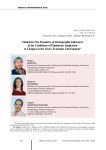
Статья научная
Socio-economic development of any territory is inherently connected with population reproduction, which is predetermined by demographic behavior. Recently, the models for the dynamics of Russia's demographic indicators have been changing, which is characterized by a decrease in the birth and death rates, as well as a relative stabilization of the migration situation. The transformation of demographic dynamics models is a natural result of society's adaptation to the new socio-economic reality. The changes in the behavior of the population are particularly noticeable under the conditions of abrupt transformations of the external environment, observed in the transitional periods of socioeconomic systems functioning. In this regard, the purpose of the study was to determine the main models of the dynamics of demographic indicators of the Russian Federation at the present stage of development, which is characterized by a rapid change in the conditions of life activity. Based on the use of the concept of adaptation in the “human-environment” coordinates, we showed the two-dimensional adaptation of the population to changes in the external environment and constructed a decision-tree for the acts of demographic behavior. In empirical part of the study, using methods of logical and statistical analysis, we studied the dynamics of indicators of reproductive, self-preservation and migration behavior of the population in the period from 2000 to 2019, using, respectively, a set of indicators of birth rate, mortality, life expectancy and migration growth. Based on highlighting the specific characteristics of Russia's socio-economic development in 2000-2006, 2007-2015, and 2016-2019, we identified three stages of demographic indicators dynamics, in accordance with which we proposed three models of demographic indicators dynamics, in order to expand our understanding of this phenomenon. The results obtained allowed us to form a methodological basis for future interdisciplinary research in the field of demographic behavior. They can also be used as a methodological basis for the development of demographic policy measures.
Бесплатно
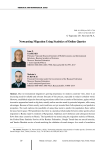
Nowcasting migration using statistics of online queries
Статья научная
Due to international migration’s growing importance in modern countries’ lives, there is an increasing need for reliable and relevant forecasts of this process, especially in today’s turbulent world. However, established migration forecasting procedures suffer from a number of limitations, against which innovative approaches based on big data, notably online searches made by potential migrants, offer many advantages. Because of their novelty, such tools have not yet revealed their full explanatory and predictive properties. The work explores the possibility of using these tools to predict the population flows within the post-Soviet space. We hypothesize that there is a statistical relationship between online queries about migration to Russia made by residents of Kyrgyzstan, Tajikistan and Uzbekistan and subsequent human flows from these countries to Russia. The hypothesis was tested using the migration statistics of Rosstat, the Federal State Statistics Service of the Russian Federation, Google Trends data on search intensity, and Yandex Wordstat service of word matching for validation of search images. As a result of correlation and regression, we found a moderate dependence of the dynamics of human flows on previous queries, which is most evident at a lag of 6-9 months and at zero lag. Obtaining more accurate results in this and similar studies is hindered by the initial limited predictability of migration behavior due to its contextual, sometimes situational and irrational nature, as well as “noisiness” of statistics of queries and often the flows themselves. The search for universal algorithms of determination of relations between queries and migration flows is seen as the main direction of research in this field.
Бесплатно
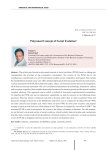
Polycausal concept of social evolution
Статья научная
The article puts forward a polycausal concept of social evolution (PCSE) based on taking into consideration the structure of the competition mechanism. The novelty of the PCSE lies in the simultaneous consideration of a set of interrelated variables of the competition mechanism that exclude the establishment of simple cause-and-effect relationships typical of monocausal theoretical constructions. A structural scheme of the PCSE includes the subject, object, environment and the process of competition; all of them are directly associated with such civilizational phenomena as technology, institutions, culture and ecosystem; together, these variables determine the nature of economic growth and the type of capitalist (market) relations. This approach can be called a method of structural (organizational) competition. To illustrate the PCSE and test its explanatory capabilities, we look for answers to the following classic questions: Why has human civilization matured in Eurasia rather than in other continents? How did humanity manage to break out of the Malthusian trap? How can we explain the Needham Puzzle? Why are some countries and peoples rich, while others are poor? Why do some poor countries and peoples manage to catch up with rich ones, while others do not? How can we explain the “case of the USSR”? The proposed PCSE is used to reconstruct key events in the history of human civilization. For this purpose, we put forward a structural outline of social evolution, which includes basic principles and mechanisms that determine certain results of the development of human societies. In conclusion, we make an attempt to use the PCSE to designate reference points of a modern civilizational crisis.
Бесплатно
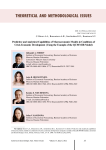
Статья научная
The article deals with the use of econometric macromodels for solving applied problems to substantiate economic policy. The questions of the applicability of econometric methods for modeling economic processes are considered. The requirements for the key qualities of complex macroeconomic models are being formed. Emphasis is placed on the fact that it is econometric modeling based on large amounts of data that contributes to a deep analysis of the causal relationships existing in the economy. As an illustration, we use the description of the quarterly macroeconomic model QUMMIR, which has been used for a decade and a half at the Institute of Economic Forecasting of the Russian Academy of Sciences for medium-term forecasting. It is shown that in conditions of increasing economic uncertainty, the importance of analyzing scenarios of socio-economic development and substantiating economic policy measures aimed at tapping the internal potential of economic development increases. We argue that the use of advanced predictive and analytical tools can significantly improve the quality of forecast estimates and the validity of decisions made on their basis. The structure of the model is described in detail with an emphasis on budget and financial blocks. The final part of the article provides an example of using a quarterly macroeconomic model to analyze decisions in the field of fiscal and monetary policy. Calculations demonstrate a positive impact on the dynamics of GDP on the part of budget system expenditures in the absence of a significant effect on the growth of inflation. In terms of monetary policy, calculations demonstrate its relative neutrality in relation to economic dynamics, as well as the exhaustion of the positive impact on the economy in the current conditions due to the weakening of the ruble exchange rate.
Бесплатно
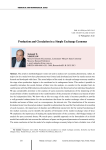
Production and circulation in a simple exchange economy
Статья научная
The article is methodological: it does not seek to analyze new economic phenomena; rather, its major aim is to study how these phenomena were formed and developed and how the market system was formed and developed with them. The actual subject of the study is a simple exchange economy model at the stage when production begins to be considered as its endogenous factor. This makes it possible to smoothly introduce the social division of labor into the analysis, to consider in the simplest form its combination with the differentiation of production functions in the framework of an individual household. We pay considerable attention to the analysis of socio-economic implications of the deepening of the social division of labor manifested in the transformation of the production of objects and means of labor into its independent links. We show why at this very stage of the study it becomes possible to provide a well-grounded substantiation for the mechanisms that form the market exchange value of consumer durables and means of labor, and, as a consequence, the interest rate. The introduction of the resource limitation factor into the analysis makes it possible to substantiate the need for the institution of ownership of such resources, the importance of absolute and differential natural rent for the normal functioning of the market economy, and to identify the specifics of formation of the market exchange value of land. We emphasize the importance of making the spatial dimension of the economy a full-fledged subject of analysis for pure economic theory. We touch upon a possible approach to the formulation of an initial model that would take into account the influence of space on the general parameters of economic activity. The main conclusion is that the model of a simple exchange economy helps to form a holistic view of all key categories (albeit in embryonic forms) reflecting the action of the market mechanism. At the same time, it becomes clear why further institutional transformations are required to realize all the potentials available in this form of economic activity organization.
Бесплатно

